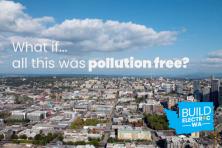We spend more than 90% of our time inside buildings—our homes, workplaces, daily errands, and social activities. Seem like a lot? This year we’ve only been driven indoors more during the COVID-19 pandemic and recent wildfires and smoke across the West.
The energy we use to heat and power our buildings are a major source of greenhouse gas emissions—in Oregon and Washington, second only to transportation. Why are our buildings such a big source of pollution? Because we still use and prioritize burning fossil gas (misleadingly called “natural gas” by, well, the gas industry) in our homes and buildings. Even with Oregon and Washington’s relatively clean electricity grids—which will only get cleaner for Washington as the state transitions towards 100% emissions-free electricity by 2045—growth, development, and a continued reliance on gas appliances only furthers and lengthens our dependence on this emissions-heavy source of energy.
Cities and states across the United States are recognizing these climate, health, and safety risks, and are creating policies to move towards all-electric building construction. 35 cities in California have committed to going gas-free since last year, with Massachusetts, California, New York, and New Jersey also exploring phasing out gas. It’s time for us here in Washington and Oregon to also address buildings emissions.
In this new series of blog posts, we’ll be unpacking the case for making our buildings all-electric to reduce emissions; increase our public health and safety; and create good, lasting, family-wage jobs while saving utility customers money on their bills.
Why do all-electric buildings matter?
Fossil gas is harmful across its entire lifecycle. Firstly, most of the fossil gas used in the Pacific Northwest is produced through hydraulic fracturing, also known as fracking. While both Washington and Oregon have instituted moratoriums on fracking sites within our states, the majority of the gas piped into Washington and Oregon is fracked gas from other states or Canada. Gas extraction largely takes place on or near tribal or First Nations lands, creating health and safety risks for those indigenous communities; for example, babies born near natural gas flaring (common in fracking) are 50% more likely to be premature. And of course fracking and transporting fossil gas can lead to methane leaks – which may have even led to the recent spike in global methane emissions.
After extraction, fossil gas is piped into our homes and buildings where it is used primarily for space and water heating, as well as powering cooking appliances like stoves and ovens. And it’s here where it grows beyond climate to become a health and safety issue. Emissions from buildings are growing at a faster rate than any other source of carbon pollution in the state. Combusting gas indoors contributes significantly to both indoor and outdoor pollution and impacts our health—any gas that doesn’t fully combust is released into the air outside and also decreases air quality inside our homes. Lastly, pumping gas through highly pressurized pipelines, especially in an earthquake prone region, puts us at constant risk of gas leaks, explosions, or fires.
Fortunately, the technologies to fully electrify our buildings, such as heat pumps, are already available and in common practice. As part of this blog series, we’ll go into more detail to the myriad of ways home and commercial builders are already using these technologies at cost-effective and efficient rates and how electrifying our buildings will also create new jobs. Notably, the new Key Arena, a major entertainment and sports facility in Seattle, Washington, will be 100% fossil free—the so-called Climate Pledge Arena will be heated, support cooking, and more without any fossil gas at all.
Why now?
Both Washington and Oregon are legally bound to reduce greenhouse gas emissions at an aggressive rate as both states updated their statewide emissions reductions goals in 2020. Oregon’s governor signed an executive order establishing the state’s greenhouse gas reduction goals of at least 45% below 1990 levels by 2035 and at least 80% below 1990 levels by 2050; similarly, Washington passed a 2020 commitment to reducing GHG emissions by 95% below 1990 levels by 2050. Electrifying our buildings and reducing dependency on burning fossil gas is essential and would be the lowest-cost pathway to meeting these goals.
The past year has also caused us to focus even more on the quality of air we breathe and the immediacy of impacts from emissions on our health. COVID-19 and wildfires have not only pushed many of us to spend more time indoors, but also make gas use an even riskier practice. We’ve seen in real time this year that breathing dirty air and living with worsening air pollution, whether from smoke or pollutants from gas cooking appliances, can increase our risk of death from COVID-19. All-electric buildings can help with the twinning crisis of COVID-19 and climate change in two ways—not only will we move away from the use of climate and air polluting fossil gas, but as we continue to see peak temperatures rise in the Northwest, we will need ways to adequately cool our homes and buildings to cope with heat-related health impacts. All-electric heat pump technology comes with cooling benefits (aka air conditioning) that will be essential to keeping vulnerable people safe during increasingly extreme and deadly heat waves or wildfires, and ensure access to clean, affordable, and reliable home comfort.
To protect our residents, Washington and Oregon need to join the movement towards clean, safe, all-electric buildings—and we need to do it soon. Look out for more information on the case for all-electric buildings and the policy solutions that can get us there in the Northwest.
Want to learn more about buildings emissions?
Check out our Climate Leaders Live webinar: Clean and Safe Buildings with Electrification
Watch recording here: password (case sensitive) DvpH7!lx





